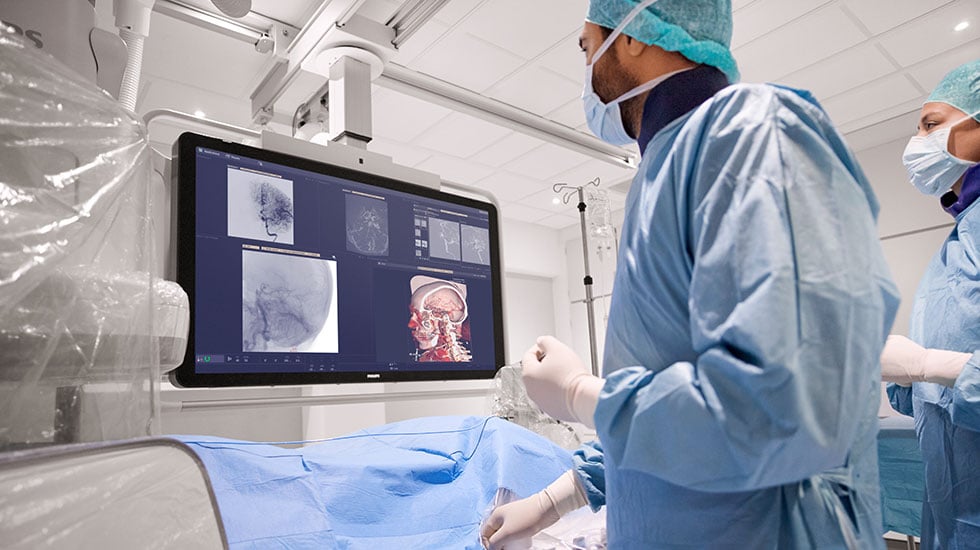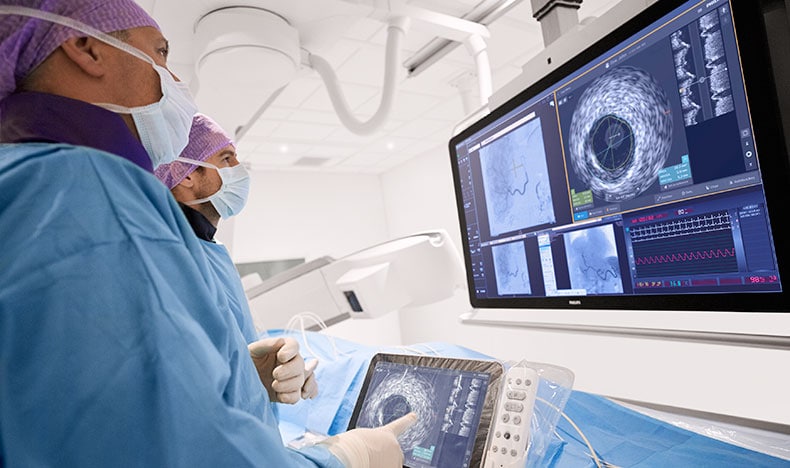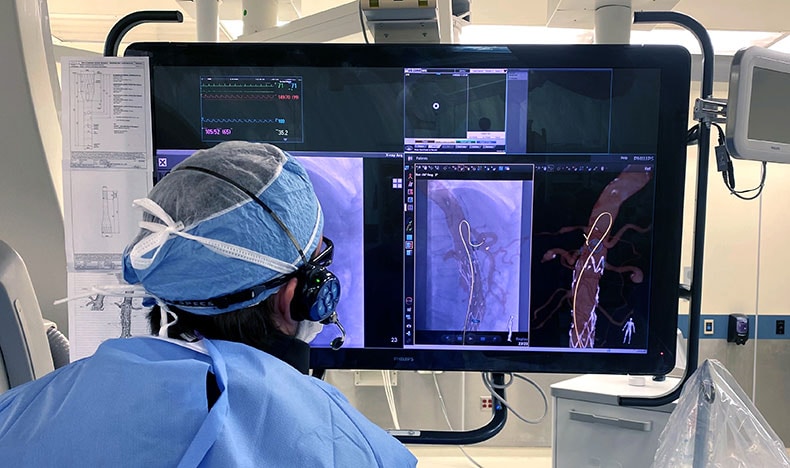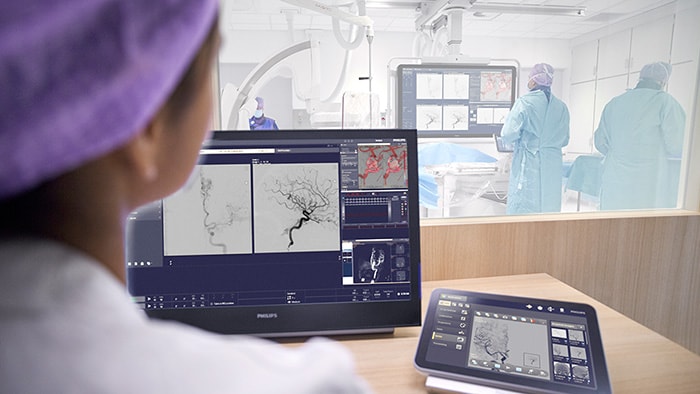“Taking it to a whole other level.” How Azurion is changing the world of surgery
Feb 27, 2024 | 6 minute read
It can move around a room full of doctors like a character in a computer game. It’s been likened to using a smart phone for the first time, with all the intuitive capabilities and future possibilities that brings. And it helps to save or improve the life of one patient every single second somewhere on Earth: Azurion, Philips’ innovative image-guided therapy (IGT) platform, still sets the industry standard for improving surgical procedures. Now, seven years after it was first launched, Azurion 3.0 is continuing to change the world of surgery – supporting more complex and innovative cases, and enabling more doctors to treat more patients, quickly and safely.

A springboard for innovation
One in 10 people undergo a surgical procedure each year. And as the world faces up to the challenges of caring for growing populations with fewer resources, healthcare needs to move faster than ever before, by innovating new ways to treat patients more precisely.
Ever since the 1950s, Philips has played a leading role in the development of image-guided treatments. By bringing together powerful innovations like 3D imaging, smart catheters, AI, and Augmented Reality, the company has helped to advance the IGT field through placing stents, replacing heart valves, and correcting heart rhythm disorders, to the local treatment of cancer and minimally invasive procedures of brain disorders using catheters.
Today, Azurion is still the benchmark in the industry when it comes to superior image quality with low dose. Designed with clinicians from all over the world, as well as experts from the gaming industry, the platform is helping to transform how patients are treated for a broad range of the world’s most common illnesses, including cardiovascular and neurovascular diseases. With the latest version – a neuro biplane system featuring enhanced imaging capabilities and ergonomic gantry positioning flexibility – Azurion is focused on taking stroke care to the next level.
Advancing stroke care
Stroke is the leading cause of disability in the world, and every second counts when it comes to treating a patient. But today 40% of people still arrive too late in the hospital to get the right treatment. That treatment depends on physicians being able to quickly identify the cause of the stroke. To do so, a patient is usually given a CT or an MR, and then taken to a different area of the hospital for treatment. For the first time, Azurion 3.0’s state-of-the-art 3D CT-like imaging enables doctors to diagnose and treat a stroke patient in the same room, saving precious time.
In the last couple of years, we’ve seen the neurovascular market growing at rapid pace, especially due to the increasing number of stroke patients treated in our biplane Angio rooms around the globe,” says Mark Stoffels, Global Business Unit Leader of IGT at Philips. “With our current portfolio and biplane we already have a strong proposition for neuro procedures, due to outstanding usability and image quality. For stroke teams coordination, effective collaboration and time are incredibly critical. Leveraging today’s technological advancements we were able to design a new system that is even more flexible, faster and easier to use for the team to acutely treat those patients (in urgent need of a mechanical thrombectomy). With the introduction of the new Azurion neuro biplane our customers can further increase the efficiency of neurovascular procedures while putting them a step closer to the ability to send patients with a suspected stroke directly to the Angio suite for fast diagnosis and treatment, saving valuable minutes and potentially improving clinical outcomes.”
We often see these glossy photos of what healthcare is supposed to look like, but the reality is 22 people all crowded together to save a patient – and it’s amazing to see Azurion working around all of them.
Making a real-life difference
The day-to-day reality of surgical procedures is often messy, complex, and time pressured. Physicians need to move faster and make sense of a huge amount of information – from medical images, disease-specific diagnostic devices, and patient data. The Azurion platform helps them by bringing that information together in one intuitive interface.

“As an interventionalist, we want to be in the cockpit, similar to a pilot in an airplane, where we have control of everything we need and have all the relevant functions at our fingertips,” says Barry T Katzen, founder and chief medical executive emeritus of Miami Cardiac & Vascular Institute, Baptist Health South Florida, USA. “Philips’ next generation image-guided therapy platform just takes it to a whole other level and allows interventionalists to accomplish the procedures quicker and more efficiently, which benefits the patient.”
By helping to simplify complex surgical procedures and amplify the skills of clinicians, Azurion makes a tangible difference to the people in the room, says Dr Atul Gupta, Philips’ Chief Medical Officer of Image-Guided Therapy and Precision Diagnosis and practicing diagnostic and interventional radiologist. “I remember visiting Cincinnati Children’s Hospital and seeing a procedure with 22 physicians in the same room treating a tiny baby. And Azurion was part of enabling their life-saving efforts. I thought ‘this is real life.’ We often see glossy images of what healthcare is supposed to look like. But the reality is 22 people working together to save a patient. And our platform works with them, for them, and around them.”
Developed with gaming experts
Part of how Azurion does that is thanks to the design of FlexArm, the mounted ceiling system introduced in 2019. Philips brought in experts from the gaming industry, where they were designing controllers and usability, and asked them to look at the physician’s behavior in the Angio room, as well their hand-eye coordination when they moved the system around the patient. The gamers applied the same complex mathematics used to move avatars in a computer game to enable FlexArm to pivot around the patient and clinicians in all directions, without getting in anyone’s way. It means that the physician can now control the detector as easily as a gamer controls their character.
Why integrating devices matters
During a minimally invasive procedure, clinicians are guided not only by imaging, but also advanced medical devices that provide additional information about the patient’s status. Azurion brings together a wide range of devices and images onto one single touchpad.
This integration of devices is not just a technical nice-to-have – it can save lives. Traditionally, devices are a separate piece of equipment that is wheeled into the room on a cart and plugged into the system. And they provide vital additional information to the physician about their patient.
Take IntraSight, which looks at the inside of a patient’s vessels. That’s crucial for complex coronary procedures when the physician needs to know whether something is blocking that vessel. Integrating IntraSight into Azurion, so that all a physician needs to do is tap one button on the touchpad, means that precious time and space are saved. In an emergency like a heart attack, or if the patient is treated late at night when staff levels can be low, that timely information can make all the difference.
Azurion also supports complex cardiovascular procedures, like aortic repairs: a physician can now see inside the patients without X-ray, using a Philips innovation called LumiGuide. The device, which works exclusively with Philips interventional systems like Azurion, acts like a human GPS system using light – taking healthcare one step closer to radiation-free procedures.

A future proof platform
The story of Azurion began with a vision: of a platform that could help doctors and hospitals to tackle the healthcare challenges the world is now facing. Since version 1.0 was launched in 2017, more than five million patients have been treated in more than 90 countries using an Azurion system. Thanks to its ability to add innovative new solutions as they mature – like robotics, AR, and VR – the platform ensures that physician will be able to enhance their skills and perform complex life-saving procedures well into the future. “Azurion is a great connector,” says Dr Atul Gupta. “Not just of systems and solutions, but of people.”
Read the press release about Philips’ new Azurion neuro biplane system aimed to speed up and improve minimally invasive diagnosis and treatment of neurovascular patients.
Media contacts
Get our latest news by e-mail
Share on social media








